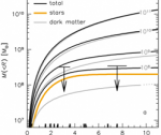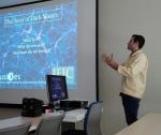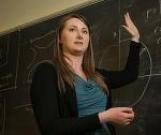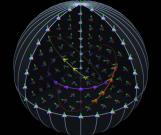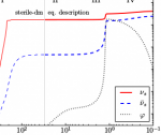Articles & Interviews
- 05/06/2018The model which describes the world around us is called “The Standard Model” of particle physics. It includes many particles like the very well know electron, the photon, the Higgs particle (sometimes called The God Particle), the quarks and many more.
- 16/05/2018Paper of the month: A galaxy lacking dark matterNew observations of the ultra-diffuse galaxy NGC1052-DF2, published in Nature by van Dokkum et al., seem to show that it contains an unusually low amount of dark matter, perhaps barely any at all. This conclusion was reached after independently computing the luminous and gravitational mass of the galaxy, which, contrary to all other galaxies observed up to date, seem to match. This means that there is little room for the presence of non-luminous (or “dark”) matter in NGC1052-DF2. This striking observation may pose a challenge to popular dark matter paradigms and raises the question of what astrophysical processes could have lead to its formation.
- 16/05/2018The observed antineutrino flux from nuclear reactors is consistently lower than predicted. This anomaly could hint at oscillations of active neutrinos into a new sterile neutrino species, or it could simply be a reflection of underestimated systematic uncertainties in the theoretical flux prediction. We review the status of both hypothesis in view of recent developments. In particular, we scrutinize recent Daya Bay results, which aim to determine whether the deficit depends on the isotope from which neutrinos are produced (as would be likely if the problem is with the flux prediction), or is independent thereof (as would be expected if the sterile neutrino hypothesis is true). We also comment on new short-baseline data, and we discuss reactor data in the context of a global fit. Please see document attached.
- 24/04/2018Paper of the month: Neutrino tomography of the EarthA recent analysis done by A.Donini et. al [1] measures the density profile of the Earth using atmospheric neutrinos. Even though neutrinos are weakly interacting particles, cosmic rays scattering with the nuclei of the atmosphere produce a high energetic neutrino flux with a non-negligible probability to interact with the nucleons of the Earth, when passing through it. Using a one-year muon data set measured by the IceCube neutrino telescope [2], it is possible to infer the Earth’s density profile. This method provides a new way to study Earth’s internal structure and although the idea is not new, this work represents the first attempt at applying it using actual data. This is the first time we can actually see the interior of the Earth by means of neutrino tomography and obtain non-trivial results.
- 20/04/2018Rachel Houtz recently wrote an article for El País. She explains for the general public how a recent precision measurement of the fine-structure constant restricts dark photon parameters space. The article appeared on the El País website on April 18, 2018.
- 19/04/2018The ESRs spoke at Hamamatsu Photonics on April 18, 2018
- 13/04/2018Julia Gehrlein gave a short talk on IFT Responds (IFT Responds) on October 24, 2017
- 13/04/2018Julia Gehrlein gave a short talk on IFT Responds (IFT Responde) on February 11, 2017
- 11/04/2018The outreach book is coordinated by Quintín Garrido
- 11/04/2018Julia Gehrlein gave a short talk on IFT Responds (IFT Responde) on February 7, 2018
- 10/04/2018Rachel Houtz gave a short talk on IFT Responds (IFT Responde) on February 9, 2018
- 22/03/2018Bruno Martin reports from Fermilab on the state of the DUNE collaboration and its scientific aims
- 07/03/2018Xabier Marcano discusses the recent creation of a three-dimensional skyrmion in a quantum gas in an article in El País newspaper
- 05/03/2018Paper of the month: An Unexpected Absorption Profile in the 21cm SpectrumA recent announcement from the Experiment to Detect the Global Epoch of Reionization Signature (EDGES) [1], published in Nature on March 1st, 2018, has caught the attention of the cosmology and particle physics community worldwide. The EDGES collaboration has announced an observation based on a measurement of the 21-centimeter (21cm) hyperfine transition in neutral hydrogen that calls into question the legitimacy of the Lambda Cold Dark Matter model (ΛCDM), a theory that treats the entirety of dark matter as cold and non-interacting, and has been held in high regard for accurately modeling current cosmological observations over a huge range of scales.
- 21/02/2018Paper of the month: Sterile Neutrinos as DM candidatesOne possible solution to the Dark Matter puzzle is the extension of the Standard Model of particle physics by sterile neutrinos, which, unlike the known neutrinos, do not interact via the fundamental forces of the Standard Model, they only interact gravitationally. Sterile neutrinos represent a natural extension to the Standard Model and feature in various neutrino mass generation mechanism
- 11/01/2018Paper of the month: Search for hidden-photon dark matter with the FUNK experimentOne of the most fascinating mysteries of physics today is the nature of dark matter. We know from many astrophysical and cosmological observations that a large fraction of matter in the universe is non-baryonic, invisible matter, called Dark Matter (DM). DM interacts gravitationally with ordinary matter and remains hidden to us because it doesn’t interact with the electromagnetic spectrum, and is therefore invisible to current instruments.
- 19/12/2017Paper of the month: DAMPE: a spectral break and a new excess in the TeV spectrum of cosmic-ray electrons and positronsHigh-energy cosmic rays, i.e., particles traversing the space at energies which are much larger than their rest masses, provide a probe of galactic high-energy processes. They may shed light on the nature of such intriguing phenomenon as Dark Matter (DM) by maybe enabling observation of DM annihilation or decay.
- 24/11/2017Paper of the month: Imprints of the Dark Sector in Gravitational WavesEinstein’s theory of relativity interprets gravity as an effect of the curvature of spacetime. As massive objects move, they should produce ripples in spacetime. These ripples would carry energy in the form of gravitational radiation, and thus they were dubbed “gravitational waves” (GWs).
- 24/10/2017Paper of the month: A long time ago in a galaxy far, far away...The origin of ultra energetic cosmic rays has been a mystery over the past 50 years. On September 2017, the Pierre Auger Observatory reported an anisotropy in the 3 x 10^4 cosmic rays recorded with energies above 8 x 10^8 eV. This anisotropy, detected with a significance above 5.2σ, indicates an extragalactic origin for these particles; that is, they are likely to be produced far away from our galaxy.


